Potentially hazardous agents in land-applied sewage sludge: human health risk assessment
This report on the risks to human health is part of the research project undertaken by the James Hutton Institute on the impacts on human health and environment arising from the spreading of sewage sludge to land (CR/2016/23).
This document is part of a collection
3.3. Organic contaminants
3.3.1. Background
Organic contaminants are chemical substances that persist in the environment, bioaccumulate through the food web, and pose a risk of causing adverse effects to human health. They include industrial chemicals (such as polychlorinated biphenyls - PCBs), unintentional by-products of industrial processes (such as dioxins and furans), incomplete products of combustion (e.g. polycyclic aromatic hydrocarbons - PAHs), flame retardants (such as Polybrominated diphenyl ethers - PBDEs) and plasticisers (such as Benzyl butyl phthalate - BBP). Organic contaminants can enter waste water treatment plants (WWTPs) from a variety of sources including urban and agricultural run-off, domestic wastewater and industrial point source discharges and also via atmospheric deposition. Organic contaminants are typically lipophilic (fat soluble) and hydrophobic, and sorption to sewage sludge solids is the primary pathway for their removal from wastewater.
The application of sewage sludge to land, whether on to the soil surface or through incorporation in to the topsoil, will directly expose the soil and any associated crops to organic contaminants. Similarly, atmospheric deposition will result in soil exposure to organic contaminants and potential crop uptake via roots or leaves. Some non-persistent organic pollutants, such as lesser molecular mass PAHs, can be degraded during composting (Brandli et al., 2007) and in the soil, but other contaminants such as PCBs or polychlorinated dibenzodioxins and furans (PCDDs/Fs) could accumulate in soil when contaminated sewage sludge is applied repeatedly (Umlauf et al., 2011).
The migration of pollutants, in particular from soil to plants, could facilitate a potential entry pathway into the human food chain and subsequent human exposure. The magnitude of plant uptake, as well as the pathway by which organic contaminants enter vegetation is a function of the chemical and physical properties of each pollutant. Experiments and model simulations have shown that persistent, polar (log octanol:water partition coefficient, Kow < 3) and non-volatile (dimensionless Henry's constant (the proportionality constant in Henry's gas law that states that the amount of dissolved gas is proportional to its partial pressure in the gas phase) < 10–6) contaminants generally have the highest potential for accumulation from soil into plants. Concentrations in roots and leaves may even exceed the concentrations in soil (in some cases by several orders of magnitude), which among other things is because the water content in roots (up to 95%) usually is higher than in soils (about 30%). Volatile contaminants have a low potential for accumulation, because they quickly escape to air (Trapp and Legind, 2011).
3.3.2. Emerging contaminants
It is not the intention of this study to reiterate what has already been reported in SNIFFER (2008) and elsewhere on organic contaminants in sewage sludge. Instead, the focus of this work is on potential human health risks associated with so called 'emerging' and 'priority' organic contaminants.
Research has shown that for most 'traditional' organic contaminants plant uptake is minimal, strong sorption to the soil matrix prevents groundwater contamination and restrictions on applications to grazing grassland reduces the likelihood of ingestion by livestock. The concentration of 'traditional' chemicals in sludge has typically declined over time due to effective source control. Many are governed by the Stockholm Convention, which has eliminated or restricted the use of the organic chemicals deemed to be of most risk. However, 'emerging' chemicals (i.e. those that have not been well studied) may pose risks that are not well characterised or have not yet been identified. The 2017 EU Future Brief recognised the importance of newly emerging organic chemicals such perfluorochemicals (PFCs) and polybrominated diphenyl ethers-PBDEs (Science for Environment Policy, 2017). It acknowledged the smaller evidence base for these chemicals, which may behave in a different way to some older organic chemicals, for example binding to protein. In addition, a range of European industry organisations, (e.g. European Environmental Bureau-EEB and the European Sustainable Phosphorus Platform-ESPP), published a joint position statement in 2017 on the need for data and research on organic chemicals (and pharmaceuticals) in sewage sludge. This highlighted the threat to land application due to the real or perceived concerns about organic contaminants and the lack of information regarding "emerging" contaminants.
A number of reviews have considered which 'emerging' chemicals should be prioritised in future research (e.g. Clarke et al., 2016; Stewart et al., 2016; Thomadi et al., 2016; McCarthy et al., 2015; Jensen et al., 2012; Clarke & Smith, 2011, Table 3‑4) and these were used to select the organic chemicals that have been considered in more detail in this report (Table 3‑5). It should be noted that where a chemical is sensu stricto an organic chemical but is used primarily as a pharmaceutical or in personal care products, this chemical has not been included in the risk assessment presented here but in Section 3.4.
Table 3‑4 Identification of priority chemicals in the literature
Clarke and Smith 20111
- 10/11: PFCs
- 9/11: PCAs; PCNs
- 7/11: PBDEs; OTs; TCS; TCC
- 6/11: Benzothiazoles
- 5/11: Antibiotics, pharmaceuticals
- 3/11: Synthetic musks
- 2/11: BPA; QACs; Steroids
- 1/11: PAEs; PDMSs
Jensen et al. (2012)2
- Low risk b
- BFRs
- Musks
- Pharmaceuticals
- PCBs
- PFCs c
- For future review d
- PCAs
- PCNs
- TCC
- TCS
- Parabens
Thomaidi et al. (2016)3
- Synthetic phenolic compounds
- NP
- NP1EO
- NP2EO
- TCS
- Siloxanes
- Decamethylcyclopentasiloxane
- Dodecamethylcyclohexasiloxane
- Dodecamethylpentasiloxane
- Tetradecamethylhexasiloxane
- Benzothiazoles
- 2-hydroxybenzothiazole
- Pharmaceuticals
- Caffeine
- Benzothiazoles
Stewart et al. (2016)4
- Flame retardants
- BDE 77, 99 and 209
- TDCP,
- TPP
- TCPP
- Plasticisers
- DEHP
- BBP
- Bisphenol A
- Perfluorinated compounds
- PFOS/PFOA
Clarke et al. (2016)5
- NP, NP1EO, NP2EO (1-3)
- TCC (4)
- TCS (5)
- BPA (6)
- Carbamazephine (7)
- PBDE (8)
- PCBs (9)
- PFOA (10)
- PFOS (11)
- PCDD/Fs (14)
1 Ranking of research priorities for emerging organic contaminants in biosolids (10 highest priority to 1 least priority) perfluorochemicals (PFCs); polychlorinated alkanes (PCAs); polychlorinated naphthalenes (PCNs); polybrominated diphenyl ethers (PBDEs); organotins (OTs); triclosan (TCS); triclocarban (TCC);. bisphenol A (BPA); quaternary ammonium compounds (QACs); phthalate acid esters (PAEs) and polydimethylsiloxanes (PDMSs)
2 Prioritisation and selection of chemicals to assess the risk to soil organisms from the application of sludge (brominated flame retardants (BFR), musks, pharmaceuticals, PCBs and PFCs). Identification of chemicals for future evaluation.
3 Greece was used as case study and the environmental risk associated with the existence of 99 emerging OCCs in sludge-amended soil was estimated using risk quotient (RQ) approach. Chemical with a risk quotient >1 are listed.
4 Identification of indicator compounds for use in the assessment of organic chemical removal during wastewater treatment and their fate in receiving environments (Tris[2-chloro-1-(chloromethyl)ethyl]phosphate (TDCP); Triphenyl phosphate (TPP); Tris (1-chloro-2-propyl) phosphate (TCPP); Di (2-ethyhexyl)phthalate (DEHP); benzyl butyl phthalate (BBP); = perfluorooctanesulfonic acid (PFOS); perfluorooctanoic acid (PFOA)).
5 A quantitative risk ranking model was developed for human exposure to emerging contaminants following biosolids application to Irish agricultural land. Chemicals are ranked by predicted environmental concentration in soil.
3.3.3. Risk assessment
Chemicals listed in Table 3‑4 were included in the risk assessment if; (i) their primary application was not for pharmaceutical or personal care products, (ii) if reliable distribution coefficients were available that satisfied the requirements of the multi-media fugacity models (Section 2.2.2). The full list of organic chemicals, their physico-chemical properties and reference doses (RfD) are listed in Table 3‑5.
| Chemical | Water solubility (mg l-1 @ 25C) | Vapour pressure (mm Hg @ 25C) | Henry's constant (atm-m3 mol-1) | Log KOW | RfD (mg kg-1 d-1) / Uncertainty Factor |
|---|---|---|---|---|---|
| Benzo(a)anthracene | 9.40x10-3 (May et al. 1978) | 2.10x10-7 (Sonnefeld et al. 1983) | 1.20x10-5 (NCCT) | 5.76 (Wang et al. 1986) | 1.40x10-3 / 3000 (Hoogenboom et al., 2003) |
| Benzo(a)pyrene | 1.62x10-3 (May et al. 1983) | 5.49x10-9 (Murray et al. 1974) | 4.57x10-7 (NCCT) | 6.13 (Demaagd et al. 1998) | 3.00x10-4 / 3000 (USEPA IRIS) |
| Benzo(b)fluoranthene | 1.50x10-3(a) (Yalkowsky et al. 2010) | 5.00x10-7(b) (Coover & Sims 1987) | 6.57x10-7 (NCCT) | 5.78 (Wang et al. 1986) | 1.40x10-3 / 3000 (Hoogenboom et al., 2003) |
| Benzo(k)fluoranthene | 7.60x10-4 (USEPA 1987) | 9.65x10-10 (Murray et al. 1974) | 5.84x10-7 (NCCT) | 6.11 (Demaagd et al. 1998) | 1.40x10-3 / 3000 (Hoogenboom et al., 2003) |
| Chrysene | 2.00x10-3 (Miller et al. 1985) | 6.23x10-9 (Hoyer & Peperle 1958) | 9.40x10-7 (NCCT) | 5.73 (Hansch et al. 1995) | 1.40x10-2 / 3000 (Hoogenboom et al., 2003) |
| Indeno(1,2,3-cd)pyrene | 6.20x10-2(b) (Sims & Overcash 1983) | 1.25x10-10 (USEPA 2012) | 3.48x10-7 (NCCT) | 6.70 (USEPA 2012) | 4.90x10-5 / 10000 (USEPA Chem Dash) |
| Naphthalene | 3.10x101 (Pearlman et al. 1984) | 8.50x10-2 (Ambrose et al. 1975) | 4.40x10-4 (NCCT) | 3.30 (Hansch et al. 1995) | 2.00 x 10-2 /3000 (Shopp et al., 1984) |
| PCB 28 | 1.17x10-1 (USEPA OPERA) | 3.46x10-4 (USEPA OPERA) | 2.05x10-4 (USEPA OPERA) | 5.64 (USEPA OPERA) | 2.00 x 10-5 / 300 (Arnold et al., 1993a; 1993b; Tryphonas et al., 1989; 1991a; 1991b) |
| PCB 52 | 3.00x10-2 (USEPA OPERA) | 9.90x10-5 (USEPA OPERA) | 3.50x10-5 (USEPA OPERA) | 6.10 (USEPA OPERA) | |
| PCB 95 | 1.00x10-2 (USEPA OPERA) | 1.45x10-5 (USEPA OPERA) | 9.34x10-5 (USEPA OPERA) | 6.56 (USEPA OPERA) | |
| PCB 101 | 1.00x10-2 (USEPA OPERA) | 1.62x10-5 (USEPA OPERA) | 8.39x10-5 (USEPA OPERA) | 6.43 (USEPA OPERA) | |
| PCB 118 | 1.00x10-3 (USEPA OPERA) | 1.36x10-5 (USEPA OPERA) | 7.86x10-5 (USEPA OPERA) | 6.77 (USEPA OPERA) | |
| PCB 132 | 1.00x10-3 (USEPA OPERA) | 3.19x10-6 (USEPA OPERA) | 3.91x10-5 (USEPA OPERA) | 7.24 (USEPA OPERA) | |
| PCB 138 | 1.00x10-3 (USEPA OPERA) | 4.39x10-6 (USEPA OPERA) | 2.46x10-5 (USEPA OPERA) | 7.33 (USEPA OPERA) | |
| PCB 149 | 1.00x10-3 (USEPA OPERA) | 5.53x10-6 (USEPA OPERA) | 3.34x10-5 (USEPA OPERA) | 7.16 (USEPA OPERA) | |
| PCB 153 | 1.00x10-3 (USEPA OPERA) | 4.01x10-6 (USEPA OPERA) | 3.08x10-5 (USEPA OPERA) | 6.97 (USEPA OPERA) | |
| PCB 174 | 1.00x10-3 (USEPA OPERA) | 1.05x10-6 (USEPA OPERA) | 9.45x10-6 (USEPA OPERA) | 7.71 (USEPA OPERA) | |
| PCB 180 | 1.00x10-3 (USEPA OPERA) | 1.02x10-6 (USEPA OPERA) | 7.63x10-6 (USEPA OPERA) | 7.65 (USEPA OPERA) | |
| 2,3,7,8-TeCDD | 2.00x10-4 (Shiu et al. 1988) | 1.50x10-9 (Rordorf 1987) | 8.95x10-6 (USEPA OPERA) | 6.80 (Shiu et al. 1988) | 2.00 x 10-9 / 9.6 (COT) |
| 1,2,3,7,8-PeCDD | 1.93x10-5 (USEPA OPERA) | 6.03x10-10 (USEPA OPERA) | 1.09x10-5 (USEPA OPERA) | 6.58 (USEPA OPERA) | 2.00 x 10-9 / 9.6 (COT) |
| 1,2,3,4,6,7,8-HpCDD | 1.90x10-3 (Miyata et al. 1989) | 7.40x10-8 (Nestrick 1980) | 2.18x10-5 (Hine & Mookerjee 1975) | 8.11 (USEPA OPERA) | 2.00 x 10-7 / 9.6 (COT) |
| 2,3,4,7,8-PeCDF | 4.19x10-4 (USEPA OPERA) | 2.01x10-9 (USEPA OPERA) | 3.97x10-5 (USEPA OPERA) | 6.62 (USEPA OPERA) | 2.00 x 10-9 / 9.6 (COT) |
| 1,2,3,4,7,8-HxCDF | 2.40x10-6 (USEPA OPERA) | 2.13x10-9 (USEPA OPERA) | 9.31x10-6 (USEPA OPERA) | 7.45 (USEPA OPERA) | 2.00 x 10-8 / 9.6 (COT) |
| 1,2,3,6,7,8-HxCDF | 8.53x10-4 (USEPA OPERA) | 2.12x10-9 (USEPA OPERA) | 9.31x10-6 (USEPA OPERA) | 7.45 (USEPA OPERA) | 2.00 x 10-8 / 9.6 (COT) |
| 2,3,4,6,7,8-HxCDF | 8.55x10-4 (USEPA OPERA) | 2.12x10-9 (USEPA OPERA) | 9.31x10-6 (USEPA OPERA) | 7.45 (USEPA OPERA) | 2.00 x 10-8 / 9.6 (COT) |
| Nonylphenol | 7.00x100 (Yalkowsky & Dannenfelser 1992) | 8.18x10-4 (Bidleman & Renberg 1985) | 3.50x10-5 (NCCT) | 5.76 (Itokawa et al. 1989) | 7.50x10-3 / 1000 (USEPA Chem Dash) |
| Nonylphenol diethoxylate | 1.05x100 (ECHA 2013) | 9.14x10-9 (ECHA 2013) | 2.56x10-9 (ECHA 2013) | 5.30 (ECHA 2013) | 7.00x10-3 / 10000 (derived from USGS screening level) |
| PBDE 99 | 1.33x10-2 (EU 2001) | 3.50x10-7 (Hardy & Smith 1999) | 2.50x10-5 (NCCT) | 6.84 (Geyer et al. 2000) | 1.00x10-4 / 3000 (USEPA IRIS) |
| PBDE 209 | 1.00x10-4 (ECHA 2015a) | 6.96x10-11 (Lorber & Cleverly 2010) | 1.20x10-8 (NCCT) | 9.97 (Environment Canada 2010) | 2.00x10-4 / NR (ASTDR RAIS) |
| PFOA | 3.30x103 (Inoue et al. 2012) | 3.16x10-2 (Bhhatarai & Gramatica 2011) | 2.02x10-10 (USEPA OPERA) | 4.81 (USEPA 2012) | 2.00x10-5 / NR (ASTDR RAIS) |
| PFOS | 3.20x10-3 (USEPA 2012) | 2.00x10-3 (USEPA 2012) | 1.85x10-11 (USEPA OPERA) | 4.49 (USEPA 2012) | 3.00x10-5 / NR (ATSDR RAIS) |
| TCDP | 7.00x100 (Yalkowsky et al. 2010) | 2.86x10-7 (USEPA 2012) | 2.60x10-9 (NCCT) | 3.65 (Chem Insp Test Inst 1992) | 2.00x10-2 / NR (ATSDR RAIS) |
| DEHP | 2.70x10-1 (DeFoe et al. 1990) | 1.42x10-7 (Hinckley et al. 1990) | 2.70x10-7 (NCCT) | 7.60 (de Bruijin et al. 1989) | 2.00x10-2 / 1000 (USEPA IRIS) |
| BBP | 2.69x100 (Howard et al. 1985) | 8.25x10-6 (Howard et al. 1985) | 1.30x10-6 (NCCT) | 4.73 (Ellington & Floyd 1996) | 2.00x10-1 / 1000 (USEPA IRIS) |
(a) No temperature specified.
(b) 20C
Initial concentrations in sewage sludge were set based on the 'realistic worst case' paradigm (WRAP 2016c; Hough et al. 2012). A series of recent reviews documenting measured concentrations in sewage sludge were used and starting concentrations were derived from 90%ile values reported in these data sets (Table 3‑6).
| Chemical (IUPAC) | Concentration in Sewage Sludge (mg kg-1) | Reference |
|---|---|---|
| Benzo(a)anthracene (benzo[a]anthracene) | 8.10x10-1 | WRAP et al. 2016c |
| Benzo(a)pyrene (benzo[a]pyrene) | 6.20x10-1 | |
| Benzo(b)fluoranthene (benzo[b]fluoranthene) | 8.90x10-1 | |
| Benzo(k)fluoranthene (benzo[k]fluoranthene) | 4.80x10-1 | |
| Chrysene (Chrysene) | 1.10x100 | |
| Indeno(1,2,3-cd)pyrene (Indeno[1,2,3-cd]pyrene) | 9.60x10-1 | |
| Naphthalene (Naphthalene) | 1.40x10-1 | |
| PCB 28 (2,4-dichloro-1-(4-chlorophenyl)benzene) | 2.00x10-2 | |
| PCB 52 (1,4-dichloro-2-(2,5-dichlorophenyl)benzene) | 3.00x10-2 | |
| PCB 95 (1,2,4-trichloro-3-(2,5-dichlorophenyl)benzene) | 3.00x10-2 | |
| PCB 101 (1,2,4-trichloro-5-(2,5-dichlorophenyl)benzene) | 7.00x10-2 | |
| PCB 118 (1,2,4-trichloro-5-(3,4-dichlorophenyl)benzene) | 1.30x10-1 | |
| PCB 132 (1,2,3-trichloro-4-(2,3,6-trichlorophenyl)benzene) | 7.00x10-2 | |
| PCB 138 (1,2,3-trichloro-4-(2,4,5-trichlorophenyl)benzene) | 1.30x10-1 | |
| PCB 149 (1,2,4-trichloro-3-(2,4,5-trichlorophenyl)benzene) | 8.00x10-2 | |
| PCB 153 (1,2,4-trichloro-5-(2,4,5-trichlorophenyl)benzene) | 1.40x10-1 | |
| PCB 174 (1,2,3,4-tetrachloro-5-(2,3,6-trichlorophenyl)benzene) | 2.00x10-2 | |
| PCB 180 (1,2,3,4-tetrachloro-5-(2,4,5-trichlorophenyl)benzene) | 6.00x10-2 | |
| 2,3,7,8-TeCDD (2,3,7,8-tetrachlorodibenzo-p-dioxin) | 1.20x10-6 | |
| 1,2,3,7,8-PeCDD (1,2,3,7,8-pentachlorodibenzo-p-dioxin) | 8.80x10-6 | |
| 1,2,3,4,6,7,8-HpCDD (1,2,3,4,6,7,8-heptachlorodibenzo-p-dioxin) | 1.20x10-4 | |
| 2,3,4,7,8-PeCDF (2,3,4,7,8-pentachlorodibenzofuran) | 1.10x10-5 | |
| 1,2,3,4,7,8-HxCDF (1,2,3,4,7,8-hexachlorodibenzofuran) | 1.50x10-5 | |
| 1,2,3,6,7,8-HxCDF (1,2,3,6,7,8-hexachlorodibenzofuran) | 1.60x10-5 | |
| 2,3,4,6,7,8-HxCDF (2,3,4,6,7,8-hexachlorodibenzofuran) | 1.40x10-5 | |
| Nonylphenol (4-nonylphenol) | 2.38x102 | Gibson et al. 2005 |
| Nonylphenol diethoxylate (2-[2-(4-nonylphenoxy)ethoxy]ethanol) | 1.35x102 | González et al. 2010 |
| PBDE 99 (1,2,4-tribromo-5-(2,4-dibromophenoxy)benzene) | 2.45x100 | Harrison et al. 2006 |
| PBDE 209 (1,2,3,4,5-pentabromo-6-(2,3,4,5,6-pentabromophenoxy)benzene) | 2.45x100 | Harrison et al. 2006 |
| PFOA (2,2,3,3,4,4,5,5,6,6,7,7,8,8,8-pentadecafluorooctanoic acid) | 2.40x10-5 | Zareitalabad et al. 2013 |
| PFOS (1,1,2,2,3,3,4,4,5,5,6,6,7,7,8,8,8-heptadecafluorooctane-1-sulfonic acid) | 1.10x10-5 | Zareitalabad et al. 2013 |
| TDCP (tris(1,3-dichloropropan-2-yl) phosphate) | 2.60x10-1 | Marklund et al. 2005 |
| DEHP (bis(2-ethylhexyl) benzene-1,2-dicarboxylate) | 2.70x100 | Bright & Healey 2003 |
| BBP (2-O-benzyl 1-O-butyl benzene-1,2-dicarboxylate) | 3.80x10-1 | Bright & Healey 2003 |
Combining partition coefficients (Table 3‑5) with initial concentrations in sewage sludge (Table 3‑6) within Equations 2‑6 - 2‑9, it was possible to estimate the concentrations of each organic contaminant that would remain in soil vs. migrate to soil pore water or soil pore air (Figure 3‑6). Those contaminants with the greatest propensity to partition into the soil pore water are subsequently more likely to be taken up by food crops or pasture, and therefore enter the human food chain.
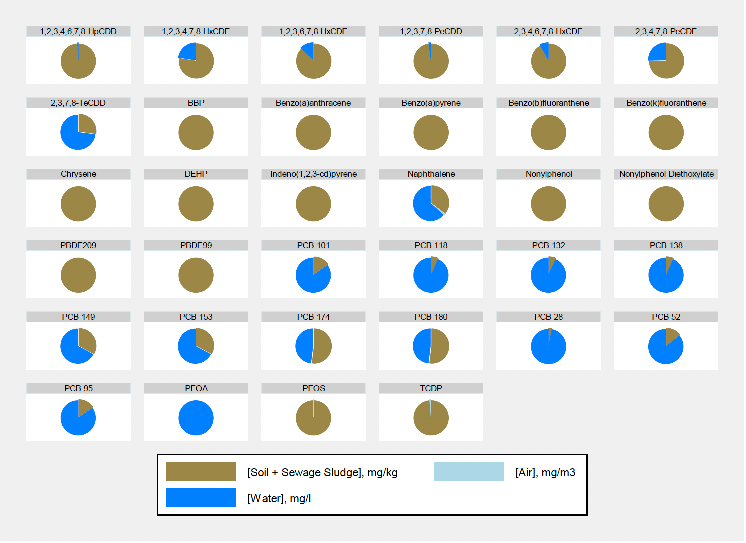
Concentrations of each organic contaminant in root crops, leafy vegetables, cereal crops, groundwater (private drinking supplies) and volatilisation to air were estimated using Equations 2‑10, 2‑11 & 2‑12. These were related to human exposure by assuming that a proportion of produce consumed was from the locations where sewage sludge was applied, a proportion of the air breathed in was derived from air into which contaminants had volatilised into, and a proportion of the water consumed was derived from a supply into which contaminants had leached. Using realistic worst case assumptions, the following proportions were selected (Table 3‑7) and estimates of exposure for each individual organic contaminant calculated (Figure 3‑7). For comparability with other studies, exposure attributable to the sum of PAHs (PAH, Figure 3‑8), PCBs (PCB, Figure 3‑9), and PCDD/Fs (PCDD/F, Figure 3‑10), were also calculated.
| Media | Consumption rate of contaminated media | Assumptions |
|---|---|---|
| Water | 1.44x10-5 L d-1 | An individual whose main household supply is a private well in close proximity to sewage spreading activities. Assuming an average consumption rate of 1.2 L d-1 (Hough et al. 2010b) and a total period per year when the water supply is affected by sewage sludge applications of 28 days (i.e. fractional exposure of 0.12), averaged over 1 year. A dilution rate of 104 is assumed. |
| Air | 1.38x10-5 m3 d-1 | An individual who resides within 1 km of sewage spreading activities. Assumes 100% partially conducive weather conditions (see Figure 3‑2). Assumes inhalation rate of 180 m3 d-1 outdoors (Hough et al. 2004) and a total period of 28 days when the air is affected by sewage sludge volatiles. A dilution rate of 106 is assumed. |
| Soil | 1.76x10-5 kg d-1 | Assumes the 95th%ile soil ingestion rate for an adult (Hough et al. 2004 and references therein) and that 25% of all soil ingestion is derived from locations where sewage sludge has been spread. Given that all organic chemicals adsorb and accumulate in soil, the fractional exposure is considered to be 1, i.e. 365.25 days per year. |
| Roots | 1.10x10‑2 kg d-1 | Assumes the 95th%ile root vegetable (including potatoes) ingestion rate for an adult (Hough et al. 2004) and that 10% of all ingested vegetables are derived from local sources where sewage sludge has been applied to the soil. |
| Leaves | 8.08x10-3 kg d-1 | Assumes the 95th%ile leafy vegetable (including salad veg) ingestion rate for an adult (Hough et al. 2004) and that 10% of all ingested vegetables are derived from local sources where sewage sludge has been applied to the soil. |
| Cereals | 8.40x10‑03 kg d-1 | Assumes the 95th%ile bread consumption rate 2010 for an adult male (O'Connor 2012) and that 10% of all ingested bread was made with flour derived from locally grown cereals where sewage sludge has been applied to the soil. |
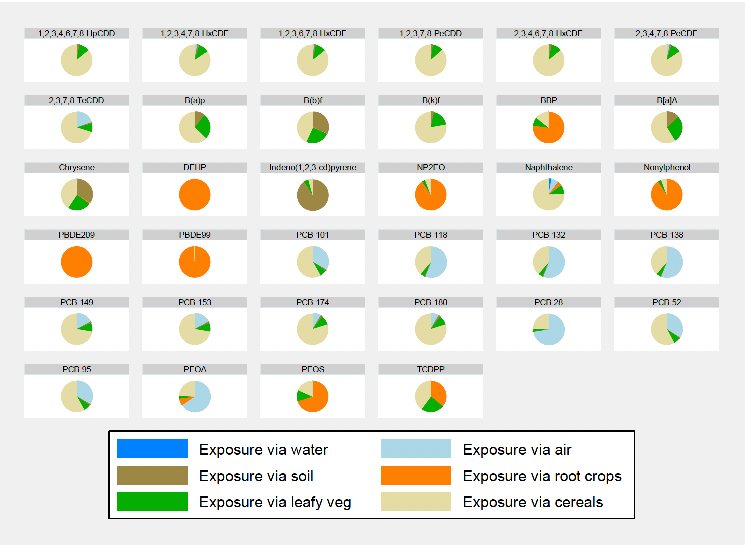
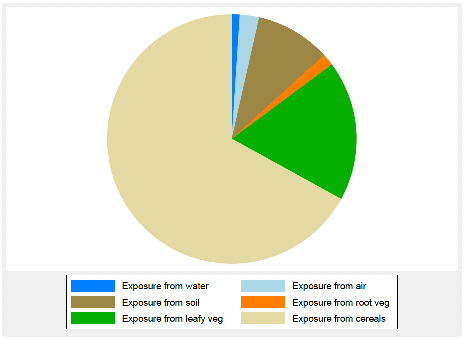
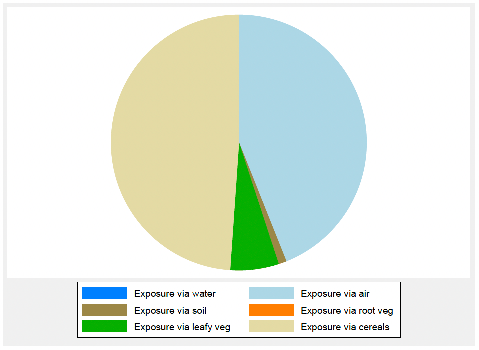
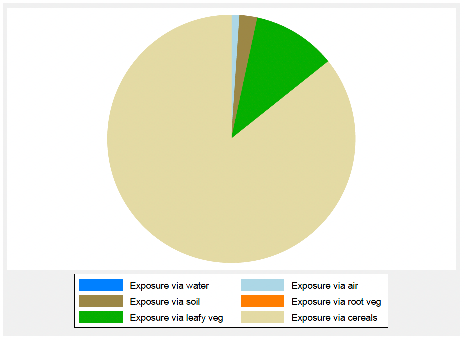
Estimates of exposure (Figure 3‑7) were compared to the reference doses (RfDs, Table 3‑5) in order to derive the Hazard Quotient, HQ as defined in Equation 2‑15 (Figure 3‑11).
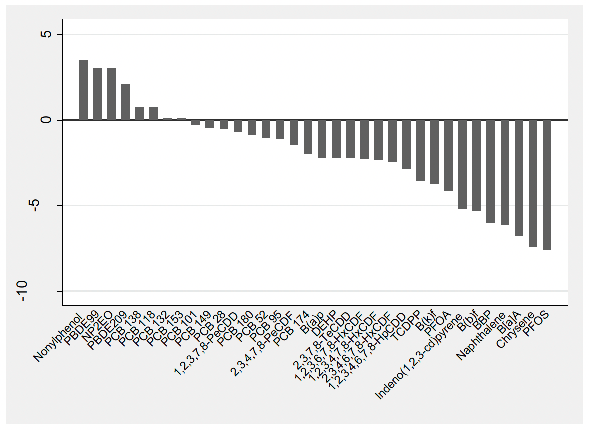
Conclusions
Even with 'realistic worst case' assumptions, the majority of the organic contaminants investigated posed no appreciable risk to local inhabitants.
The following organic contaminants returned a hazard quotient that was significantly greater than one; the detergents nonylphenol and nonylphenol diethoxylate (NP2EO), and the flame retardants PBDE-99 and PBDE-209 (Figure 3‑11); suggesting that if the worst case assumptions described above held true, these individuals would experience deleterious health effects due to lifetime exposure to these compounds as a result of sewage sludge application to land. It is interesting to note that for all these chemicals, the exposure is dominated by consumption of root vegetables (Figure 3‑7) and therefore these exposures (if proven to be real) could be mitigated by simply restricting the use of sewage sludge in root vegetable production. There are also opportunities to reduce concentrations of these chemicals in sludges via the water and sludge treatment processes, with processes such as anaerobic digestion proving effective at partially removing a number of the agents highlighted (see Table 4‑1). It should be noted that the RfD for nonylphenol diethoxylate has especially large uncertainties as it is derived from an USGS screening level for drinking water rather than from a toxicologic point of departure.
The analysis also suggests that PCB 138 and PCB 118 might also pose a risk, however given the 'realistic worst case' assumptions it is likely that this risk is minimal. The main exposure route for the PCBs is via air and therefore represents a short-term exposure while sewage sludge handling is taking place. As seen in Section 3.2, avoidance of the most conducive weather conditions as well as the use of buffer zones may reduce this exposure.
These estimates of HQ are based on realistic worst case assumptions, thus the exposure scenarios will only apply to a very small proportion of the population (if at all). The vast majority of individuals living close to sewage sludge application activities are not going to be exposed via drinking water, and it is unlikely that they will be consuming 10% of their food intake from locally-grown produce.
The use of 'realistic worst case' scenarios is a conservative approach aimed at protecting the most vulnerable in society and hence the approach tends to drive up risk estimates. This is helpful as it gives a level of confidence where we identify compounds that despite the worst case assumptions pose little risk to inhabitants. The recommendations made here have been made on the assumption that the potential exposures highlighted are subsequently found to be real and reasonably widespread.
Contact
Email: gary.gray@gov.scot
There is a problem
Thanks for your feedback